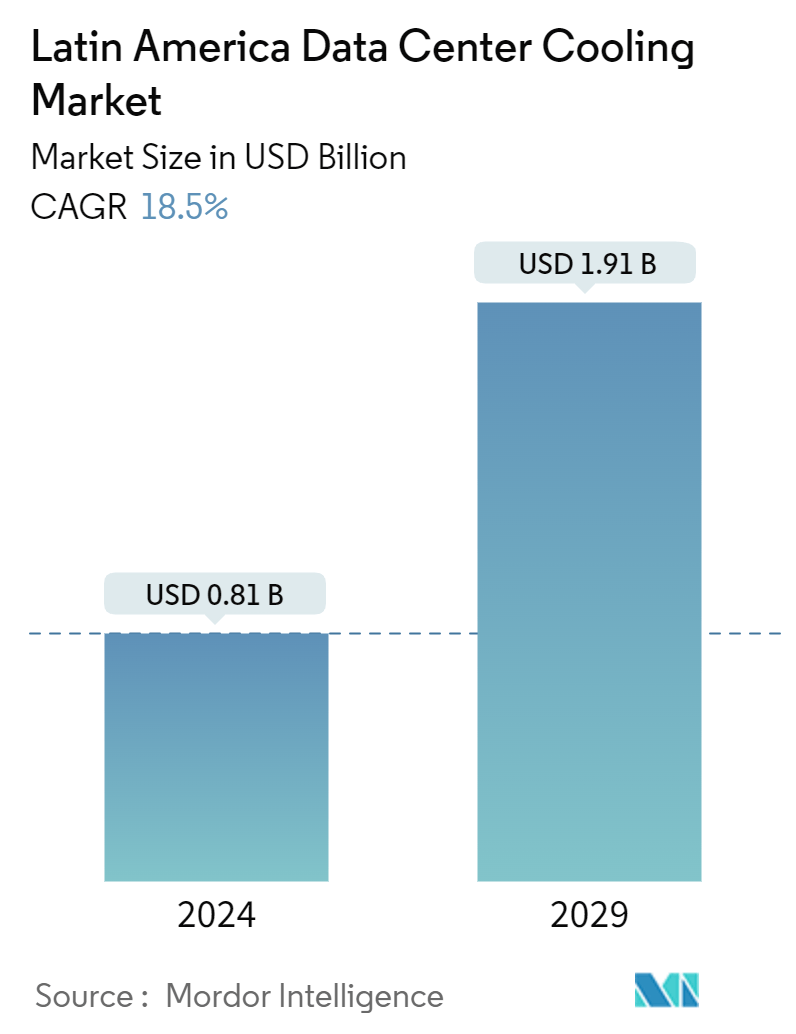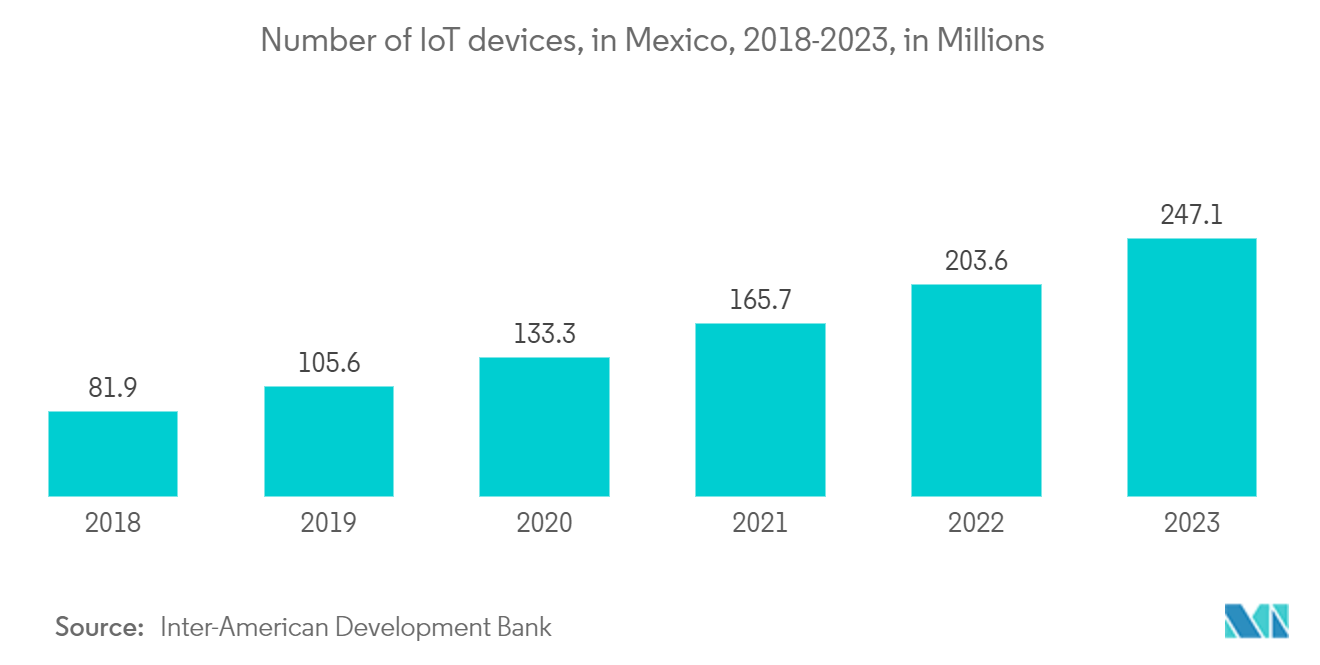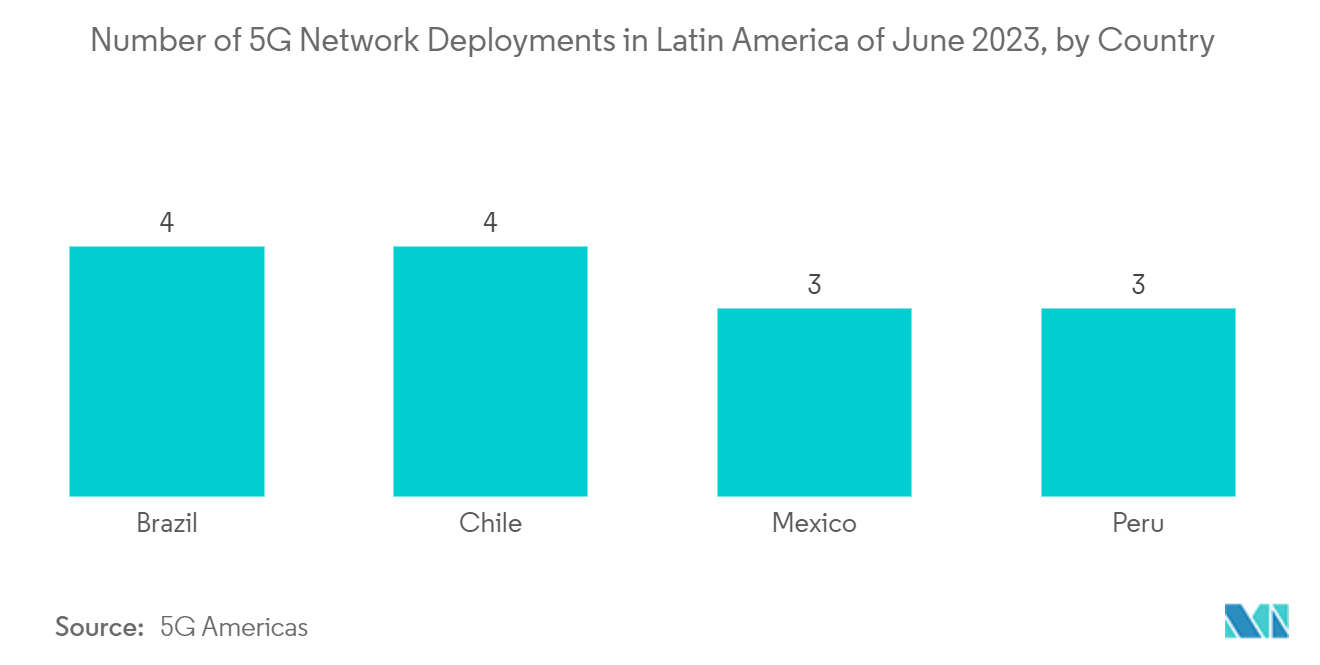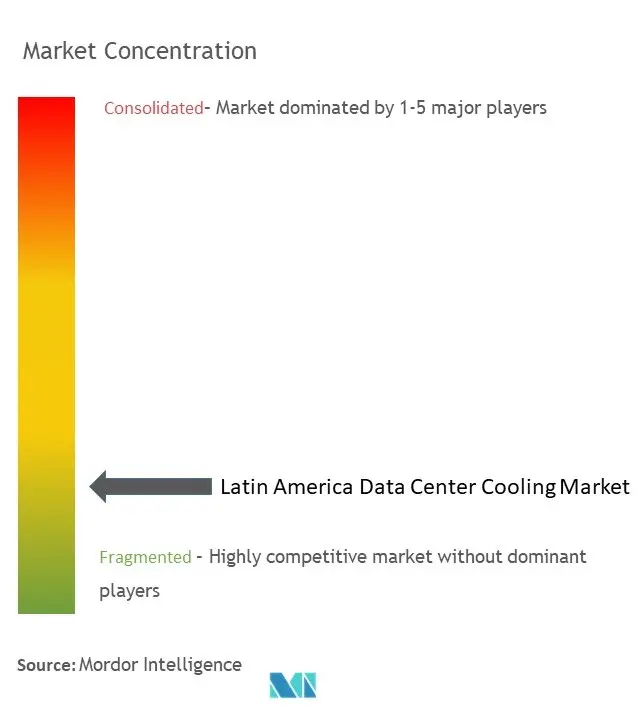Latin America Data Center Cooling Market Size

| Study Period | 2019 - 2029 |
| Base Year For Estimation | 2023 |
| Market Size (2024) | USD 0.81 Billion |
| Market Size (2029) | USD 1.91 Billion |
| CAGR (2024 - 2029) | 18.50 % |
| Market Concentration | Low |
Major Players
*Disclaimer: Major Players sorted in no particular order |
Latin America Data Center Cooling Market Analysis
The Latin America Data Center Cooling Market size is estimated at USD 0.81 billion in 2024, and is expected to reach USD 1.91 billion by 2029, growing at a CAGR of 18.5% during the forecast period (2024-2029).
Due to its cost-effectiveness, the shift from traditional air cooling technologies to liquid air cooling technologies is gaining momentum. Technological advances such as the processing of natural languages and applications using cryptocurrencies require high-performance processors and GPUs, making liquid cooling more viable. This highlights the future deployment of environmentally friendly computing technologies in data centers.
- The market examined has been strongly boosted by the growing digitization of data. As the population gets more interconnected and dependent on digital infrastructure, the demand for data centers will increase. Due to the increase in data center construction and growth, effective cold solutions are necessary as soon as possible so that optimal performance can be ensured while avoiding costly failures.
- The deployment of green data centers, which are characterized by eco-friendly buildings, energy-efficient cooling systems, and the integration of renewable energy sources, is an important factor driving the region's data center cooling market. With increased regulatory support and sustainability objectives, the demand for modern eco-friendly cooling systems in data centers is expected to increase further.
- In order to obtain real-time information on cooling performance, data center operators use advanced monitoring systems and analytical tools. This allows for improved reliability and efficiency through proactive maintenance, predictive analytics, and the optimization of the cooling infrastructure.
- Moreover, data centers, dynamic workloads, and variable needs for computer resources are common. When workloads change, the heat load on cooling systems changes. They must adapt and be expandable to accommodate the needs of a data center refrigeration system that can efficiently cool equipment under different load conditions while adapting to them.
- In addition, energy consumption in data centers is rising as a result of the increasing teleworking and Internet activities created by the COVID-19 pandemic. This has led to an increasing rate of developments in sustainable cooling technologies.
Latin America Data Center Cooling Market Trends
Information Technology Industry to Witness Highest Growth
- In order to perform its tasks, the IT industry requires on-premise private data storage centers and hyperscale data centers of their own size. In addition, the growth in software-as-a-service providers that allow cloud service providers to extend their capacities and are also expected to lead to increased demand for air conditioning equipment at data centers has led to increasing adoption of cloud storage.
- The vital critical environment for information technology is the removal of heat from data centers. More heat is generated in data centers as new computing equipment becomes more compact and consumes the same or more electricity than previous models.
- Furthermore, cloud storage use has expanded over the years as SaaS provider expansion has enabled cloud storage providers to expand their capacity, which is likely to raise demand for data center cooling systems. To improve the efficiency of cloud processes, cloud service providers like Microsoft, Amazon Web Services, and Google are increasing storage capacity. They are investing in hyperscale transactions.
- The demand for data centers is on the rise as technology-driven cloud computing, artificial intelligence, and the Internet of Things continue to evolve. Companies are expanding their digital footprints, needing bigger data centers or a number of smaller facilities scattered throughout the region.

Brazil to Witness Highest Growth
- In Latin America, more modern technologies are rapidly adopted. Direct-to-chip technology and the latest cooling technologies are increasingly being funded by data center investors. The importance of data centers at the edge was enhanced as a result of global developments in 5G networks, which Brazil has already become one of the first to adopt.
- There is a rapid increase in the number of people and organizations using the Internet. Due to its high population level, as well as an increase in end users' data consumption, this country is one of the main markets for data center operations. The emerging Internet of Things, which encourages the construction of new data centers to handle exponentially growing amounts of information that consumers and business users generate, is driving a sharply increased demand for hyperscale data centers.
- Moreover, due to the increasing demand for cloud services and digital transformation, hyperscale data centers have seen a significant increase in construction. To keep the high-density infrastructure in place and to ensure maximum efficiency of operations, it is essential that these data centers are equipped with new cooling technologies.
- Furthermore, the adoption of advanced heat management equipment in data centers. With a view to improving energy efficiency and reducing environmental impact, data center operators are looking into the possibilities of liquid cooling in regions such as wet or dry. Direct-to-chip cooling is also being investigated, along with new techniques for air management.

Latin America Data Center Cooling Industry Overview
The Latin American data center cooling market is highly competitive by nature and appears to be fragmented due to the presence of several prominent players. Key strategies traced from the analysis of recent developments of the market players include agreement and partnership, acquisition, expansion, and product launch. These key players strive to deliver comprehensive solutions that can reduce the expenditure incurred with the cooling systems.
- May 2024: Stulz unveiled its latest innovation, the CyberCool Coolant Management and Distribution Unit (CDU), specifically engineered to optimize heat exchange efficiency in liquid cooling solutions. The product line comprises four models, available in two distinct sizes. These units boast an impressive heat exchange capacity, ranging from 345 kW to 1,380 kW. Stulz has set the rated water supply temperature for the facility water system at 32°C (89.6°F), with the liquid supply temperature for the technology cooling system pegged at 36°C (96.8°F).
- October 2023: Mitsubishi Heavy Industries Ltd introduced a new 40 kVA-class 12-ft container-type data center with an immersion/air-cooled hybrid cooling system capable of simultaneously housing servers utilizing three types of cooling methods: air cooling (8 kVA), immersion cooling (25 kVA), and water cooling (8 kVA).
Latin America Data Center Cooling Market Leaders
-
Vertiv Group Corp.
-
Stulz GmbH
-
Schneider Electric SE
-
Rittal GmbH & Co. KG
-
Asetek A/S
*Disclaimer: Major Players sorted in no particular order

Latin America Data Center Cooling Market News
- May 2024: Rittal, in collaboration with multiple hyperscale data center operators, developed a modular cooling system. This solution boasts a cooling capacity exceeding 1 MW, achieved through direct water cooling. It is specifically tailored to cater to the high-power densities of AI applications.
- January 2024: Aligned Data Centers, the technology infrastructure company providing sustainable, innovative, and adaptive scale data centers and build-to-scale solutions for global hyperscale and enterprise customers, introduced its DeltaFlow liquid cooling technology, a patent-pending solution built to support the high-density compute requirements of next-generation applications and high-performance computing, including artificial intelligence, machine learning, and supercomputers. DeltaFlow extends Aligned’s ExpandOnDemand capabilities, providing customers the flexibility to scale and pivot to support shifting computing environments seamlessly.
Latin America Data Center Cooling Market Report - Table of Contents
1. INTRODUCTION
- 1.1 Study Assumption and Market Definition
- 1.2 Scope of the Study
2. RESEARCH METHODOLOGY
3. EXECUTIVE SUMMARY
4. MARKET INSIGHTS
- 4.1 Market Overview (Coverage: A Detailed Analysis Of The Current Regional Trends Related To Data Center Cooling Are Included In This Section)
-
4.2 Key Cost Considerations for Cooling
- 4.2.1 Analysis of the Key Cost Overheads Related to DC Operations With an Eye on DC Cooling
- 4.2.2 Key Innovations and Developments in Data Center Cooling
- 4.2.3 Key Energy-efficiency Practices Adopted in Data Centers
5. MARKET DYNAMICS
- 5.1 Market Drivers (Key Factors Such as the Increased Emphasis on Energy Consumption, Move Towards Green Solutions are Mapped Based on Their Relative Impact Over the Next 5-7 Years)
- 5.2 Market Challenges (Key Factors Such As The Dynamic Nature Of Regulations, Evolving Customer Needs Are Mapped Based On Their Relative Impact Over The Next 5-7 Years)
- 5.3 Market Opportunities
- 5.4 Comparison of Raised Floor With Containment & Raised Floor Without Commitment
- 5.5 Industry Ecosystem Analysis
6. ANALYSIS OF THE CURRENT REGIONAL DATA CENTER FOOTPRINT
- 6.1 Regional Analysis of IT Load Capacity & Area Footprint of Data Centers (for the period of 2017-2030)
- 6.2 Regional Analysis of the Established DC Markets and Emerging DC Hotspots in Latin America region (we will include coverage by highlighting major established and emerging DC markets)
- 6.3 Regional Analysis of Regulatory Framework On DC Cooling
7. DATA CENTER COOLING MARKET SEGMENTATION
-
7.1 By Cooling Technology (Key trends, market size estimates & projections for the period of 2022-2029 and future outlook)
- 7.1.1 Air-based Cooling
- 7.1.1.1 CRAH
- 7.1.1.2 Chiller and Economizer
- 7.1.1.3 Cooling Tower (covers direct, indirect & two-stage cooling)
- 7.1.1.4 Other Air-based Cooling
- 7.1.2 Liquid-based Cooling
- 7.1.2.1 Immersion Cooling
- 7.1.2.2 Direct-to-Chip Cooling
- 7.1.2.3 Rear-Door Heat Exchanger
-
7.2 By End-user Vertical
- 7.2.1 IT and Telecom
- 7.2.2 Retail and Consumer Goods
- 7.2.3 Healthcare
- 7.2.4 Media and Entertainment
- 7.2.5 Federal and Institutional Agencies
- 7.2.6 Other End-user Verticals
-
7.3 By Country***
- 7.3.1 Mexico
- 7.3.2 Brazil
- 7.3.3 Chile
8. COMPETITIVE LANDSCAPE
-
8.1 Company Profiles
- 8.1.1 Vertiv Group Corp.
- 8.1.2 Stulz GmbH
- 8.1.3 Schneider Electric SE
- 8.1.4 Rittal GmbH & Co. KG
- 8.1.5 Asetek A/S
- 8.1.6 Alfa Laval AB
- 8.1.7 Iceotope Technologies Limited
- 8.1.8 Green Revolution Cooling Inc.
- 8.1.9 Chilldyne Inc.
- 8.1.10 Airedale International Air Conditioning Ltd
- *List Not Exhaustive
9. INVESTMENT ANALYSIS
10. MARKET OPPORTUNITIES AND FUTURE TRENDS
** Subject To AvailablityLatin America Data Center Cooling Industry Segmentation
Data center cooling refers to the collective equipment, tools, techniques, and processes that ensure an ideal operating temperature within a data center facility. With increasing capacity and higher density, there is an increasing need for energy-efficient cooling of IT equipment.
The Latin American data center cooling market is segmented by cooling technology (air-based cooling [CRAH, chiller and economizer, cooling tower {covers direct, indirect, and two-stage cooling}, and other air-based cooling], liquid-based cooling [immersion cooling, direct-to-chip cooling, rear-door heat exchanger]), end-user vertical (IT and telecom, retail and consumer goods, healthcare, media and entertainment, federal and institutional agencies, and other end-user verticals), and geography (Mexico, Brazil, Chile, and Rest of Latin America). The market sizes and forecasts are provided in terms of value (USD) for all the above segments.
| By Cooling Technology (Key trends, market size estimates & projections for the period of 2022-2029 and future outlook) | Air-based Cooling | CRAH |
| Chiller and Economizer | ||
| Cooling Tower (covers direct, indirect & two-stage cooling) | ||
| Other Air-based Cooling | ||
| By Cooling Technology (Key trends, market size estimates & projections for the period of 2022-2029 and future outlook) | Liquid-based Cooling | Immersion Cooling |
| Direct-to-Chip Cooling | ||
| Rear-Door Heat Exchanger | ||
| By End-user Vertical | IT and Telecom | |
| Retail and Consumer Goods | ||
| Healthcare | ||
| Media and Entertainment | ||
| Federal and Institutional Agencies | ||
| Other End-user Verticals | ||
| By Country*** | Mexico | |
| Brazil | ||
| Chile |
Latin America Data Center Cooling Market Research FAQs
How big is the Latin America Data Center Cooling Market?
The Latin America Data Center Cooling Market size is expected to reach USD 0.81 billion in 2024 and grow at a CAGR of 18.5% to reach USD 1.91 billion by 2029.
What is the current Latin America Data Center Cooling Market size?
In 2024, the Latin America Data Center Cooling Market size is expected to reach USD 0.81 billion.
Who are the key players in Latin America Data Center Cooling Market?
Vertiv Group Corp., Stulz GmbH, Schneider Electric SE, Rittal GmbH & Co. KG and Asetek A/S are the major companies operating in the Latin America Data Center Cooling Market.
What years does this Latin America Data Center Cooling Market cover, and what was the market size in 2023?
In 2023, the Latin America Data Center Cooling Market size was estimated at USD 0.66 billion. The report covers the Latin America Data Center Cooling Market historical market size for years: 2019, 2020, 2021, 2022 and 2023. The report also forecasts the Latin America Data Center Cooling Market size for years: 2024, 2025, 2026, 2027, 2028 and 2029.
Latin America Data Center Cooling Industry Report
Statistics for the 2024 LA Data Center Cooling market share, size and revenue growth rate, created by Mordor Intelligence™ Industry Reports. LA Data Center Cooling analysis includes a market forecast outlook to 2029 and historical overview. Get a sample of this industry analysis as a free report PDF download.



